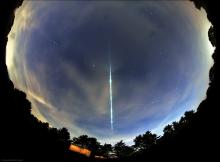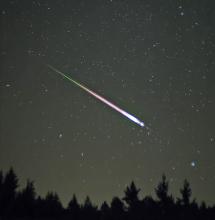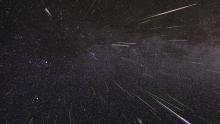Listen to today's episode of StarDate on the web the same day it airs in high-quality streaming audio without any extra ads or announcements. Choose a $8 one-month pass, or listen every day for a year for just $30.
You are here
Perseid Meteors
The Perseid meteor shower will be at its best the next few nights. This “rain” of space dust has put on some good shows over the decades. Unfortunately, though, this year’s probably won’t be one of them. The gibbous Moon will overpower all but the brightest of the “shooting stars.”
The Perseids occur every August, as Earth flies through the orbital path of Comet Swift-Tuttle. The comet is a ball of frozen gases mixed with bits of heavier rock and metal. As it approaches the Sun, some of its gas vaporizes. In turn, that releases some of the heavier material. The bits of debris are known as comet dust.
When Earth flies through this material, some of the dust grains slam into our atmosphere at tens of thousands of miles per hour. They vaporize instantly, creating meteors — streaks of light across the night sky.
Swift-Tuttle returned to the inner solar system a quarter of a century ago. That was its first appearance since the Civil War, so the Perseid showers were especially good for a while. With the comet retreating into the outer solar system, though, there’s less comet dust to feed the shower.
The shower should peak on Monday night. Its meteors enter the atmosphere from the direction of the constellation Perseus — hence the name. But they can appear anywhere in the sky, so you don’t have to look at a specific region to see them.
To view the Perseids, find a safe, dark observing site away from city lights. Then watch the sky for cosmic sparklers.





